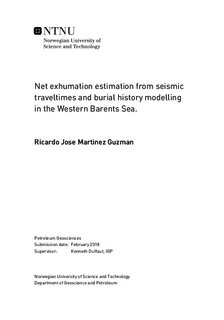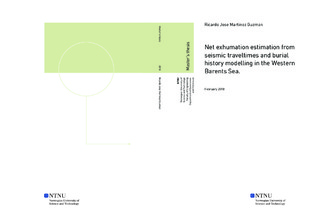| dc.description.abstract | A new seismically based technique is proposed for the estimation of net exhumation
magnitudes in sedimentary basin areas. The method uses traveltimes mapped from well
log data or pre-stack seismic data, starting from the seabed, on a reference area with only
subsidence, and from an area suspected to be uplifted. The method is compaction-based,
and allows for estimating net exhumation magnitudes at areas where severe uplift and
erosion prevent the usage of the shale compaction depth-trend technique. The technique
considers the similarity between the stratigraphic sequences from reference and uplifted
areas in terms of their NMO parameters and velocity heterogeneity. Linear P-wave velocity
functions are then estimated for both areas using dix-type mathematical relations,
and compared in a depth dependent scheme. Three sets of net exhumation magnitudes
were estimated by applying the method in nine wells spread across the Western Barents
Sea. The net exhumation magnitudes increases from the west and southwest where minor
or no uplift is predicted, towards the East and North-East, where exhumation magnitudes
between 800 m and 1700 m are estimated. Compared to the shale compaction technique,
the method is considered to be less affected by abnormal pore pressure development. The
estimates are in agreement with published net uplift magnitudes derived from shale compaction
and thermal maturity techniques, petrographical and sedimentological analysis,
etc. The net exhumation magnitudes were further used in the construction of burial history
curves for simulating mechanical and chemical compaction in clean sandstones. The
modelling scheme successfully predicts the quartz cement volumes quantified in petrographic
analysis, and the porosity, rock moduli, and velocities measured by wireline well
logging. The P-wave velocity proved to be the property least affected by factors outside
the model. The property modelling appeared to be most sensitive to the maximum temperatures
achieved according to the net exhumation magnitudes. Further empirical evidence
regarding the quality of the net uplift estimates is provided by positive correlation of the
exhumation estimates with present-day differential stress profiles. Moreover, the velocity
of exhumation-corrected Barents Sea sandstones is in agreement with published mechanical
and chemical compaction velocity depth trends, derived for unexhumed sandstones
from the Norwegian and North Sea. | |

